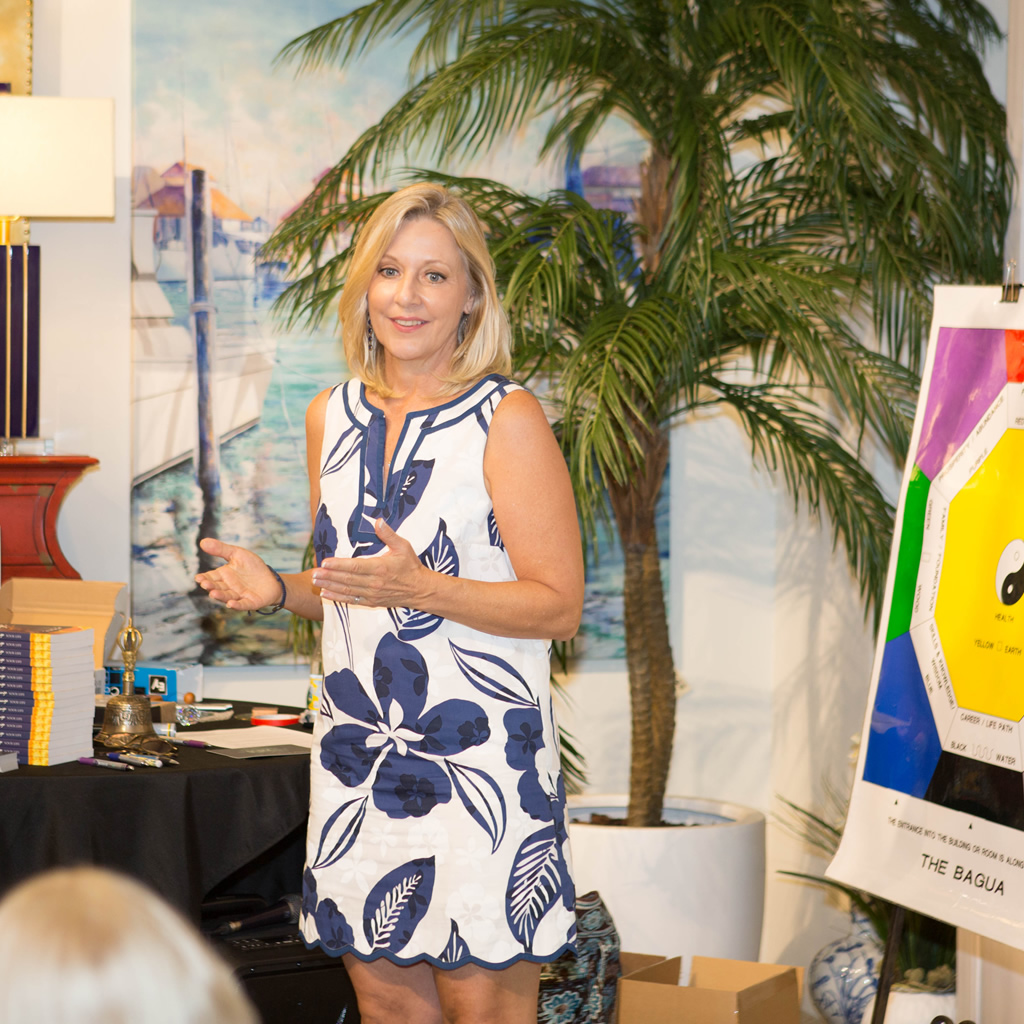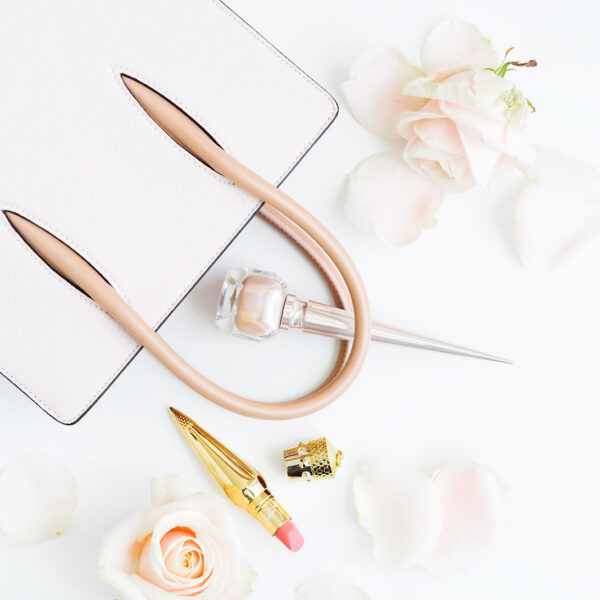In feng shui, the space between the stuff is just as important as the stuff. If your space is full, your opportunities don’t have a chance to enter. And if there’s no room for opportunity (like money, love, health, respect, etc.) in your house, there’s no room for opportunity in your life.
Clearing the Physical Clutter
When it comes to stuff in your home, a good rule of thumb is that you need at least as much space as you have stuff. The minute you have more than 50% stuff, you start slowing down your energy; lessening opportunities in life and stopping your optimal amount of money, love, and general good health from flowing in. In other words, you’ve built a roadblock in front of the candy store, and as much as you want or need a sweet fix, all you can do is window shop. With that in mind, let’s talk about clutter. Clutter is anything in your environment that is not used, loved, or has not moved one spec in at least two years. I also define clutter as having more than 50% stuff to space – period. You have to think 3D here. It’s not like I want to physically see half of the bottom of every drawer in your dresser. I’m talking about the top half of the volume of drawer space, so there is enough room to move things around and easily see what’s in the drawer. In other words, spring-loaded sock balls jumping out of the stuffed drawer as you open it is on the “no-no list.” Can you pass the 50% test? That’s 50% of your wall space (oh yea, I’ve seen walls so packed with photos, montages, and posters, it would make your head spin!) 50% of the mantel top, and 50% of the bookshelf left open. (For bookshelves, pull all the books forward, flush with the front of the shelf. The “space” is actually behind the books. And there’s a bonus: you can’t display little knickknacks in front of the books anymore – yea!) And let’s not forget the invisible clutter. Noise can be considered clutter in a space. E-clutter can also weigh heavily on a person’s energy as well. Packed hard drives and filled e-mail in-boxes can also create stifling conditions for those exposed to them. If you are starting to hyperventilate while reading this, or if you have the “I can’t even see the possibility of ever getting out from under my clutter, so what’s the point of trying” attitude, then try this technique:
A Pre-Clearing Technique for Those Who Have Surrendered to Their Clutter
Get a pack of post-it notes. Each post-it note represents one increment of time that you decide is your threshold amount of time to give to one clutter-clearing session. Perhaps each one equals five minutes, or perhaps it equals one eight-hour day. It is what you decide you are able to do. Next, go around and place a post-it note or several posts-it notes on each pile or area that needs help conforming to the 50% rule. Then, count up the notes. You can see that there is a light at the end of the tunnel, and that there is a calculable length of time to become clutter-free. Perhaps you have 60 post-it notes around your home. Then you will know that if you do one pile a day, then it will take you two months to be clutter-free. Clear some space in your schedule to de-clutter – doing one clearing session will help create the possibility for the other. It’s a very important meeting with yourself. You deserve it. Number the post-its and follow that order if it makes you feel more directed. If it stifles you – don’t. Maybe you need positive reinforcement. Begin by removing clutter from a single room, or even a single drawer and see how you feel in that room or about that drawer afterwards. It is all about being aware after all. If you’re stuck here, and are so locked up that this technique does not even seem like a possibility, or you feel your clutter-buttons are being pushed into overdrive, then take a deep breath and rest a moment. You simply have some belief – or big story – wrapped around this stuff. I might suggest my Mindset Makeover Coaching Program to help you over this hurdle. If you are ready to de-clutter now but don’t have a good de-cluttering strategy, try this:
The Five Box De-Cluttering Technique
Get 5 boxes capable of handling the amount of stuff in one session (or one “post-it pile” if you just did the pre-clearing technique.) I usually use those “banker’s” or file boxes from an office supply store. If you’re dealing with big stuff, like a garage-load, you might mark off five sections on your driveway. Label each of them as follows:
- I Don’t Know
- Give Away / Sell / Recycle
- Keep But Store
- It Belongs Elsewhere (around here)
- It Belongs Right Here
Along with these five boxes, you’ll need a trash container. Once you’ve got everything separated into five boxes, repair, clean, vacuum, or maintain the shelf, drawer, or closet you just emptied. If you haven’t moved the piece of furniture in years, I highly recommend pulling it out, and wiping down the wall behind it and wiping every part of the furniture as well. The payoff is BIG I tell you!, especially if you feel stuck, clunky, or stagnant. If you want to get your life moving, get your stuff moving. Next, let’s deal with the five boxes and the trashcan. First, the trashcan gets taken out (hopefully with recyclables separated.) Hey, that was simple! The “give away, sell, recycle” stuff goes to a charity, friends, family, or you sell it – and do I need to say in a timely manner? You want a new life fast, right? I’ll give you a week, but I hope you’ll do it faster. OK, you’re on a roll! The stuff in the “keep but store ” box gets neatly stored in the designated storage area. Remember – everything has to conform to the 50% rule – if you don’t have the storage space, then you must choose another box for this stuff! Or at the very least, and I’m not big on this; you rent space and it gets out of your immediate environment. The stuff in the “It belongs elsewhere” box get distributed around the house where they belong, and the “It belongs right here” stuff gets placed back in the area you just cleared out and cleaned up – strictly adhering to the 50% rule, of course. Finally, this is what you do with the “I don’t know” box. Put the lid on the box. Either give it to a friend or family member to hold for you for a while — say two to four months (make sure they have the space!) or tape it closed and put it in your storage area (if you have the space.) If you’re keeping it, write down in your calendar to call a friend or family member in two to four months to help you deal with this box, or tell your friend to call you in a couple of months if they’ve taken your box from you. After the time has gone by, get together with your helper and the box. Your helper opens the box in such a way that you can’t see inside. They ask you “What do you need from this box?” Whatever you need and ask for they pull it out and give it to you. (Just remember, you have to have or make space for it!) Your friend removes the rest of the stuff. They will decide what to do with the stuff. It’s no longer your decision or guilt trip. That’s it! If you don’t name it now – you don’t see it again. I recommend this method because it is an easy way to “rip off the band-aid” so to speak. Basically, what ends up going in this box are guilt trips. “I might fit into it again someday.” “I paid a lot of money for it.” “I got it for a wedding gift.” “My kid made it.” “ My mother gave it to me.” “I might be able to use it for spare parts someday.” “Even though it is broken, it is the only thing I own from Aunt Edna.” “I inherited it and have to keep it for the next generation.” “My kids left it when they moved out.” Blah, Blah, Blah. This stuff is obviously not in use at the moment. It is not loved. It is not needed at this time. And it’s definitely not emitting “My Dream Life!” vibes. Therefore it is clutter, plain and simple. Call family members that live elsewhere if you must. Perhaps they will want to take some of this stuff. But for you it is clutter and is slowing your energy and life down.
Physiological Conditions That Could Derail the De-Cluttering Process
Because I’m not there to personally hold your hand throughout this process and assess the situation, I’m going to give you two conditions where you just may need a little additional help. I have seen on occasion, a situation where it may be a person’s physiology that keeps them from being able to de-clutter. Sleep deprivation or a condition called sleep apnea is the usual diagnoses. Scientists already know – and most of us can confirm firsthand – that “lack of sleep impairs cognitive function. Sleep-restricted individuals have a shorter attention span, impaired memory, and a longer reaction time.” (Sleep/Sleep Disorders News, Jan. ‘06) They also go on to say that the part of the brain that helps you “think spatially” (as in what to do with your stuff in your space) is not able to rejuvenate itself without the proper amount of sleep. So, if you think that might be you, try getting more sleep to regenerate that part of your brain that handles organization, or visit a doctor. (There is an insomnia to-do list in the Health and Fitness chapter. Try doing those first and see if things start to unlock for you.) The other condition is a psychological one that just may be handled more quickly if you seek professional help. There is a term coined for the total fear of clutter clearing: “hoarding.” Hoarding is a condition where there is a great deal of fear associated with getting rid of anything. Chances are, if you bought this book about changing our life, you do not have this problem. If you’re not sure, and have piles so big in your house you have to think twice before asking anyone over, try this technique and see if this starts the chi rolling for you: Find a bag or container somewhere in our house and use it to cherry pick nine items from the piles each day to throw away. After nine days, raise your choices to eighteen. Then after 18 days, go to 27. Choose 27 things to be removed each day from then on until you feel a shift in your energy that gives you the fortitude to do the 5 box de-cluttering method above. If you can’t follow through with either of these techniques, consider therapy or hiring a professional organizer that has experience with this “hoarding” condition. Find someone to help you through the quagmire of inaccurate thoughts, so you can unlock your mental and physical clutter. It is possible. After clearing out the clutter, it should literally be easier to take a bigger breath (which is a hot tip if you suffer from asthma or other lung ailment.) Congratulations on having created new opportunities for yourself!






![Have you ever felt stuck in an area of your life? Feng Shui may be the key to
transform those challenges into positive energy and open the path to your life’s natural
flow. Are you willing to cross that bridge?
By applying this ancient practice, you can align your environment to attract prosperity,
well-being, and personal balance🌸 It’s more than design or decoration: it’s the tool
that connects your space with your purpose.
🌟Take the first step and discover how Feng Shui can help you move from feeling
stuck to enjoying a life full of flow and fulfillment.
➡️ Join my Feng Shui Membership for just $37/month and discover practical tips,
trainings, and tools you can apply right away to create spaces that truly support you.
Your journey to transformation starts here! → [Link in bio]
#fengshuitips #fengshui #membership](https://karenrauchcarter.com/wp-content/plugins/instagram-feed/img/placeholder.png)